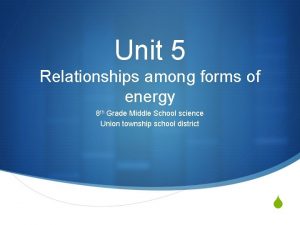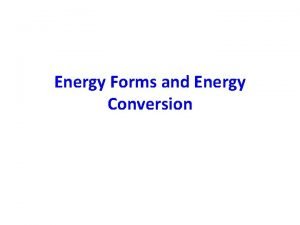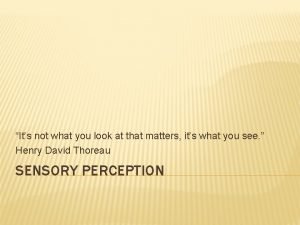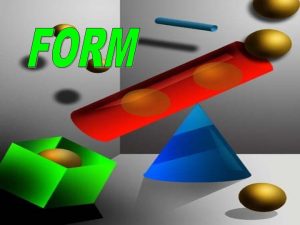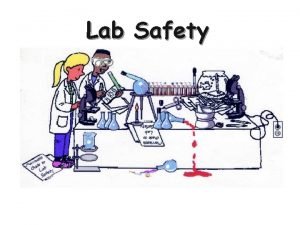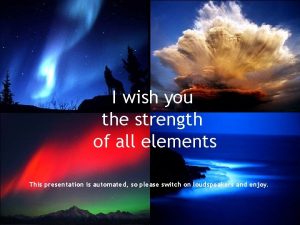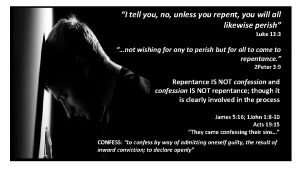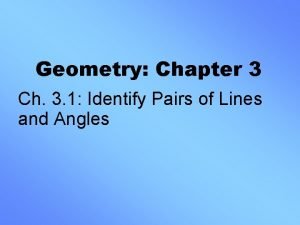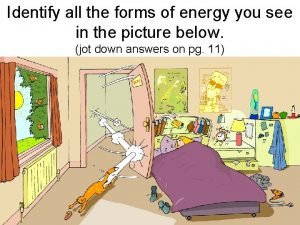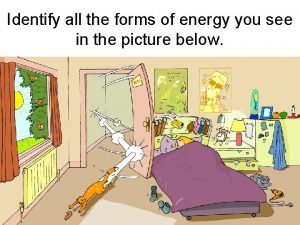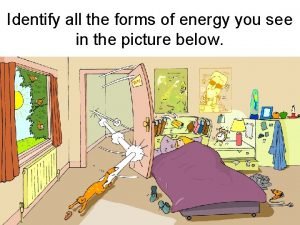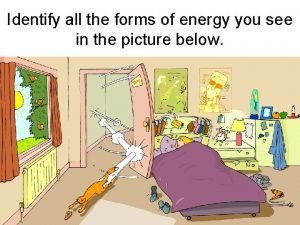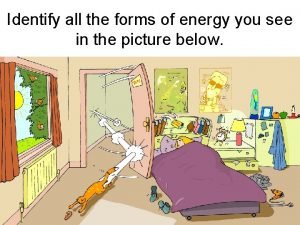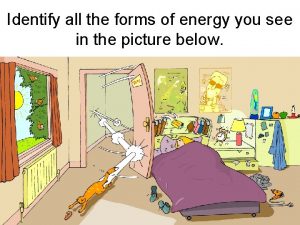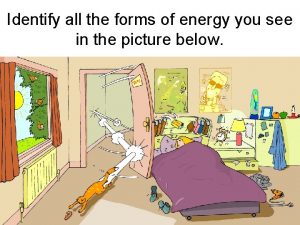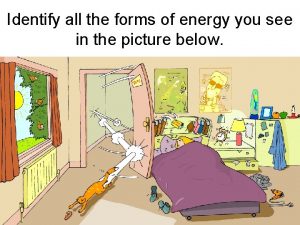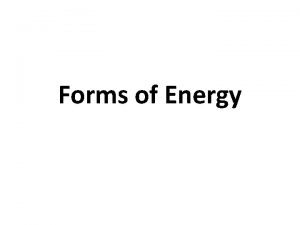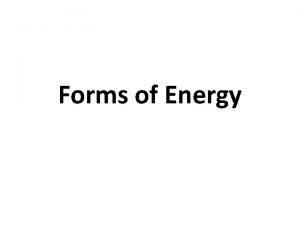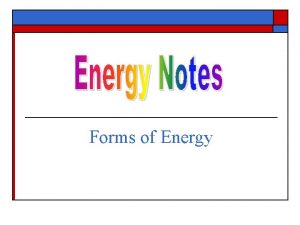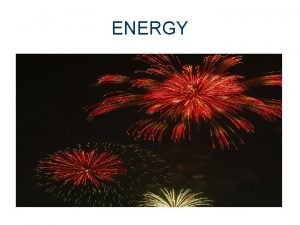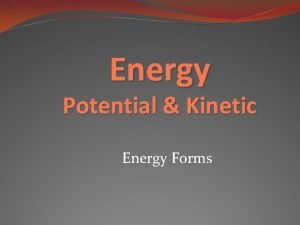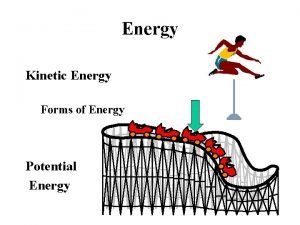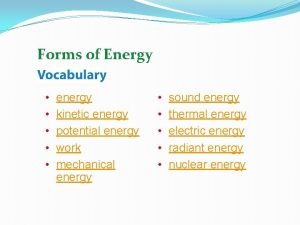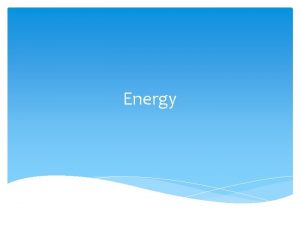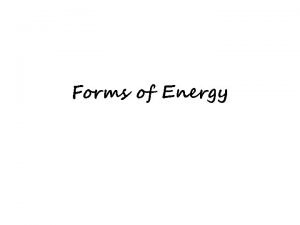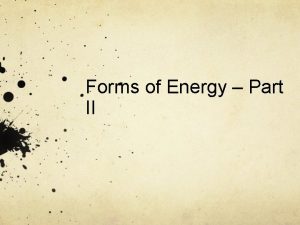Identify all the forms of energy you see


























- Slides: 26

Identify all the forms of energy you see in the picture below.

In our previous lesson, we learned that there are two types of energy: Potential Energy & Kinetic Energy There also many forms of energy. This lesson will provide an overview of some forms of energy. These forms of energy will be taught more indepth in later lessons.

There are many forms of energy, but we are going to focus on just a few. • Heat energy (Thermal) • Mechanical energy • Light (Radiant) energy • Electrical energy • Sound energy • Chemical energy • Electromagnetic energy

Use Your Graphic Organizer to Record Important Information

Heat (Thermal) Energy • Energy that is created in the movement of particles (atoms) that produces heat. • Heat (thermal) energy increases as temperature increases • The faster the particles (atoms) move, the greater the kinetic energy and the greater the object’s thermal energy. The opposite is also true. • Thermal energy also depends on the number of particles. If there are more particles, there is more thermal energy.

Heat (Thermal) Energy A hot object is one whose atoms and molecules are excited and show rapid movement. (More heat energy) A cooler object's molecules and atoms will show less movement. (Less heat

Which has more thermal energy? Why? Hot Chocolate Ice Water

Mechanical Energy • Energy of motion • The total energy of motion and position of an object (potential energy + kinetic energy) • Mechanical energy can be all potential energy, all kinetic

Mechanical Energy • The mechanical energy of an object stays the same, but the potential and kinetic energy of an object can increase or decrease. • Think of juggling. The kinetic energy decreases until all of the pin’s kinetic energy turns into potential energy, and it stops moving upward. • As the pin falls back down again, its potential energy starts changing back into

Examples of Mechanical Energy

Light (Radiant) Energy • AKA Electromagnetic Energy • Energy created by vibrating particles that create waves that travel through space and time. [These waves are called electromagnetic waves. ] • Light (Radiant) energy can be absorbed, transmitted, or reflected. • Includes energy from gamma rays, xrays, ultraviolet rays, visible light, infrared rays, microwave and radio

Examples of Light (Radiant) Energy

Electrical Energy • Energy that is carried by an electrical current (the movement of electrons, the negatively charged particles of atoms) • The electrical energy used in your home can be thought of as potential energy that is used when you plug in an electrical appliance

Sound Energy • Sound energy is caused by an object’s vibrations • A vibrating object transmits energy through the air around it in waves (longitudinal waves)

Chemical Energy • Energy stored in chemical bonds • When chemical bonds are broken, new chemicals are formed and some of it is released energy • Examples: Food, Battery, Burning candle or Wood, Fireworks, Fossil Fuels, Gasoline

Examples of Chemical Energy

What type of energy cooks food in a microwave oven? RADIANT ENERGY What type of energy is the spinning plate inside of a microwave oven? MECHANICAL

Electrical energy is transported to your house through power lines. When you plug an electric fan to a power outlet, electrical energy is transformed into what type of energy? MECHANICAL ENERGY

Gravitational Potential Energy • A type of potential energy • The energy an object possesses because of its position in relation to the surface of the Earth. • Gravitational acceleration is constant at about 9. 8 m/s 2

Elastic Potential Energy • A type of potential energy • Energy stored in objects by the application of force. Compressed springs and stretched rubber bands are examples.

What type of energy is shown below? Chemical Energy

What types of energy are shown below? Chemical, Mechanical and Radiant Energy

What type of energy is shown below? Thermal Energy

What type of energy is shown below? Chemical Energy (yummy)

What types of energy are shown below? Mechanical and Thermal Energy (Friction causes thermal energy)

According to the Law of Conservation of Energy, energy is never created or destroyed, it just changes its form. Demonstration of the Law of Conservation of Energy: Exploratorium: Science of Baseball – “Baseketball a Physicist Party Trick”
 Imaginary constellation
Imaginary constellation All forms of energy
All forms of energy Eroei
Eroei Name all the lines name all the segments name all the rays
Name all the lines name all the segments name all the rays It's not what you look at that matters, it's what you see.
It's not what you look at that matters, it's what you see. Major prophets
Major prophets Good morning i am
Good morning i am Good afternoon buenas tardes
Good afternoon buenas tardes Observatieplan stappen
Observatieplan stappen Energy energy transfer and general energy analysis
Energy energy transfer and general energy analysis Energy energy transfer and general energy analysis
Energy energy transfer and general energy analysis 馮定華神父2020
馮定華神父2020 All of you is more than enough for all of me
All of you is more than enough for all of me What are the market forms of meat?
What are the market forms of meat? Whole shellfish
Whole shellfish Why are related forms more agreeable than unrelated forms?
Why are related forms more agreeable than unrelated forms? She is short form
She is short form Why are related forms more agreeable than unrelated forms
Why are related forms more agreeable than unrelated forms Why are related forms more agreeable than unrelated forms?
Why are related forms more agreeable than unrelated forms? Weak and strong forms
Weak and strong forms I see all leads
I see all leads You must wear your safety goggles at all times
You must wear your safety goggles at all times I wish you all the strength
I wish you all the strength Unless you repent you will all likewise perish
Unless you repent you will all likewise perish What are the five fundamental questions of economics
What are the five fundamental questions of economics Identify all pairs of angles of the given type
Identify all pairs of angles of the given type Hát kết hợp bộ gõ cơ thể
Hát kết hợp bộ gõ cơ thể

